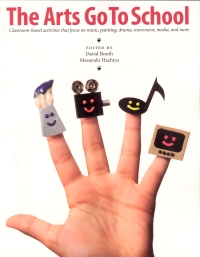| ________________
CM . . .
. Volume XI Number 14 . . . . March 18, 2005
excerpt:
Booth and Hachiya clearly outline what they offer within the pages of their guide in the introduction. This manual provides a wealth of information on the significance of an arts-based curriculum and formats into an easy-to-follow design that includes margin quotes and some visuals of children's artwork. The quotes offer comments by many leading educators and supporters of the arts-in-education. For example, accompanying the discussion entitled, "The Arts Connected to Everything We Do and See," there is the following margin quote: "I've learned that people will forget what you said, people will forget what you did, but people will never forget how you made them feel," by Maya Angelou. The manual divides into nine sections with six chapters, each presenting a brief rationale for one arts focus, plus model units demonstrating a range of strategies available to educators who want to engage in that area of arts education: * Chapter 2 - Finding Yourself in the Painting: Visual Arts in
Education, by Masayuki Hachiya Chapter 1 is dedicated to "Implementing an Arts-based Curriculum: Why the Arts Matter," by David Booth. This chapter explores the question, "Can our schools open up, even explode, the repertoire of artful choices that children could encounter each day, so that their knowledge expands, their senses grow, and their responses to life's situations become mindful and thoughtful?" Booth discusses the value of the arts in the school, community, and world, citing examples from experts, such as philosopher Maxine Greene. The final section is entitled, "Final Voices from the Arts Community. "Here, Booth includes: * Developing a School-based Arts Policy, by Jane Cutler and Lee
Willingham
plus a checklist for assessing growth in and through the arts in education, biographies of feature contributors, annotated recommended resources, references, and the index. An exhaustive collection of different ideas and perspectives on the value of an Arts-based curriculum, this manual is comprehensive without being overwhelming, and it is as practical as it is theoretical offering educators support in implementing and integrating the arts into the classroom. The Arts Go To School seems to be focused on elementary education, especially presenting a child's hand on the cover, but after reviewing this guide, I believe middle school and junior high educators would benefit by adding a copy to their own teaching materials and referring to frequently. Highly Recommended. Jocelyn A. Dimm is a sessional instructor and doctoral student at the University of Victoria where she teaches drama education and young adult literature in the Faculty of Education.
To comment
on this title or this review, send mail to cm@umanitoba.ca.
Copyright © the Manitoba Library Association. Reproduction for personal
use is permitted only if this copyright notice is maintained. Any
other reproduction is prohibited without permission.
NEXT REVIEW |TABLE OF CONTENTS FOR THIS ISSUE
- March 18, 2005.
AUTHORS
| TITLES | MEDIA REVIEWS
| PROFILES
| BACK ISSUES
| SEARCH | CMARCHIVE
| HOME |
